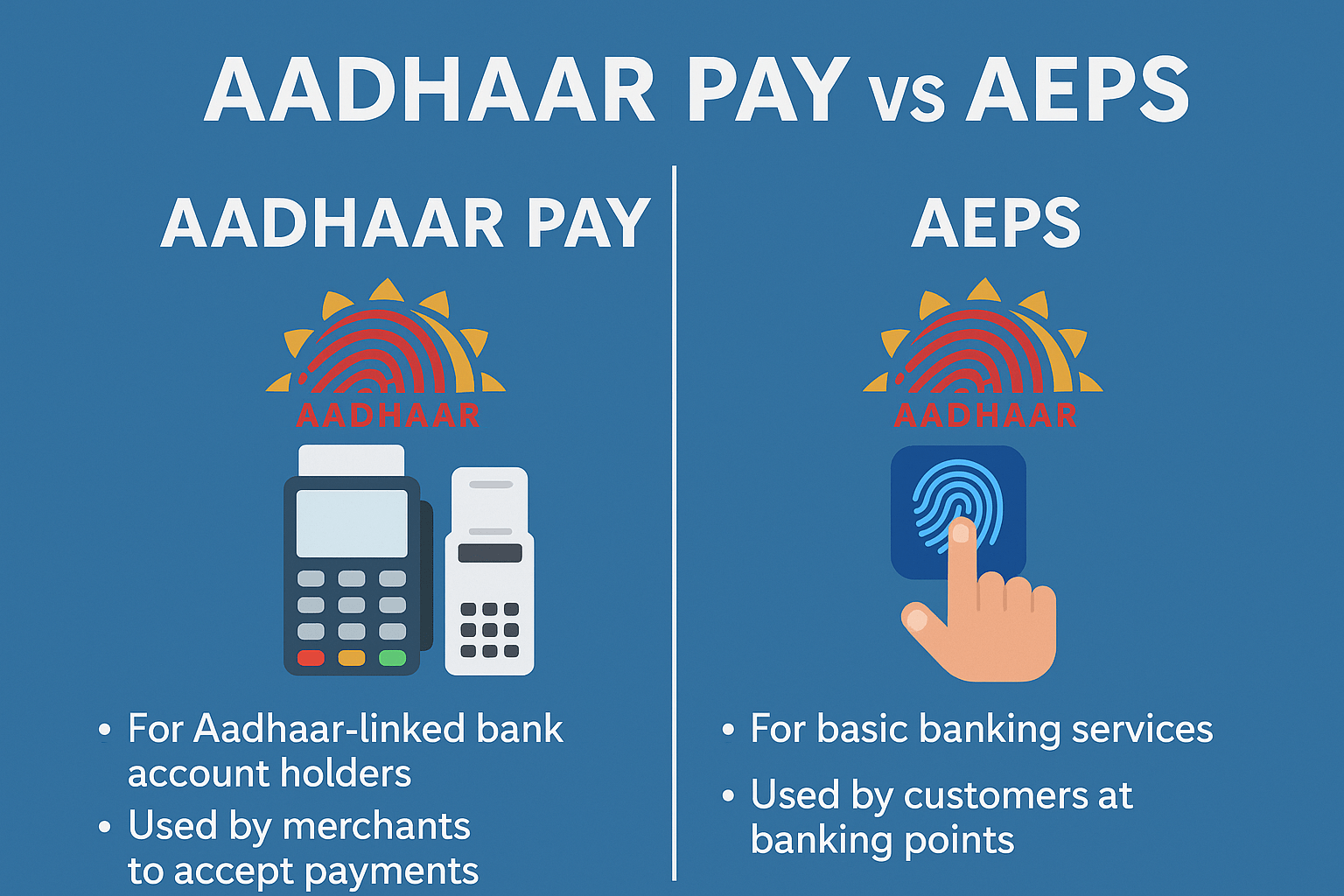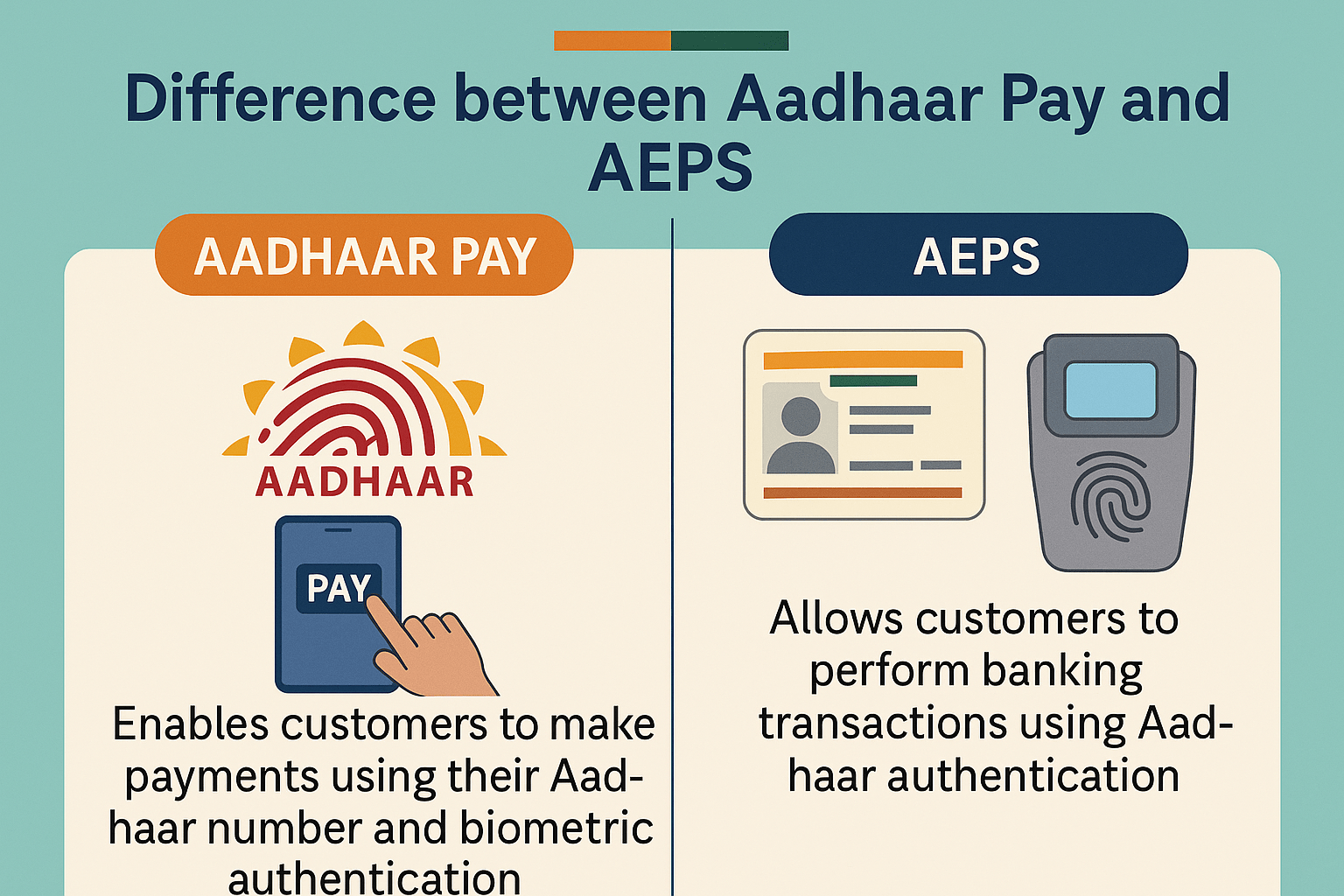In the rapidly evolving landscape of India’s digital payments (Aadhaar Pay vs AEPS) ecosystem, two terms often surface, causing confusion among millions: Aadhaar Pay and AEPS. While both leverage the power of your 12-digit Aadhaar number to facilitate financial transactions, they serve fundamentally different purposes and are designed for distinct user groups. Understanding the difference between Aadhaar Pay and AEPS is crucial for anyone looking to navigate India’s cashless economy effectively. This in-depth guide will demystify these two systems, breaking down their mechanisms, uses, and how they impact different segments of society.
The Common Thread: The Power of Aadhaar
Before diving into the differences, it’s essential to recognize the common foundation. Both systems are built on the Aadhaar Payment Bridge, a unique infrastructure that uses your Aadhaar number as a financial address. This allows for the seamless routing of transactions to your linked bank account, eliminating the need to remember complex account numbers and IFSC codes. This foundational technology is what often leads to the conflation of the two terms.
Now, let’s unravel the specifics of each.
What is AEPS (Aadhaar Enabled Payment System)?
Think of AEPS as the foundation. It’s a bank-led model that allows basic interoperable banking transactions at a MicroATM (a handheld device) operated by a Business Correspondent (BC) or a bank representative.
How does it work?
You visit a local kirana store, a BC agent, or a bank branch equipped with a MicroATM. To perform a transaction, you only need:
-
Your Aadhaar number.
-
Your bank’s name (as your account is linked to Aadhaar).
-
Your fingerprint (or iris scan) for biometric authentication.
The agent selects the type of transaction (e.g., cash withdrawal, deposit, balance inquiry), you enter your Aadhaar number, choose your bank, and authenticate with your fingerprint. The transaction is processed directly through the National Payments Corporation of India (NPCI), and the amount is debited or credited from your linked bank account.
Key Features of AEPS:
-
Objective: To promote financial inclusion and bring banking services to the doorstep of every Indian, especially in rural and remote areas.
-
Transactions: Cash withdrawal, Cash deposit, Balance inquiry, Mini statement, and Aadhaar to Aadhaar fund transfer.
-
Who uses it? Primarily used by individuals to access their own bank accounts. It’s a lifeline for those without smartphones, debit cards, or who are not tech-savvy.
-
Cost: While NPCI charges banks a minimal fee, the end-user typically does not pay anything for AEPS transactions. The agent may earn a small commission from the bank.
In simple terms: AEPS is like an ATM without a card. You use your Aadhaar and fingerprint instead of a debit card and PIN to access your own money.

What is Aadhaar Pay?
Now, let’s talk about Aadhaar Pay. If AEPS is about accessing your own money, Aadhaar Pay is about spending it merchant without needing cash, a card, or a phone.
How does it work?
Aadhaar Pay is a merchant-focused, payment acceptance system. Here’s the scenario:
-
A merchant (a shopkeeper, for example) registers for Aadhaar Pay and gets a certified biometric scanner (a specific type of MicroATM).
-
You go to buy groceries. At checkout, the merchant enters the amount to be paid on his device.
-
You enter your Aadhaar number and select your bank.
-
You authenticate the payment using your fingerprint.
-
The amount is instantly deducted from your bank account and credited to the merchant’s bank account.
Key Features of Aadhaar Pay:
-
Objective: To enable cashless payments for customers at merchant points, especially targeting those who do not use cards or mobile wallets.
-
Transactions: It is solely for making payments to merchants. You cannot withdraw cash or check your balance with Aadhaar Pay.
-
Who uses it? It is designed for customers to pay merchants. Its success hinges on widespread adoption by merchants.
-
Cost: The model was initially designed to be a zero-cost solution for customers—no transaction fees. The cost of the transaction is supposed to be borne by the merchant’s bank, which might earn from increased digital transactions.
In simple terms: Aadhaar Pay is like a POS (Point-of-Sale) machine without a card. You use your Aadhaar and fingerprint instead of swiping a debit/credit card to pay a merchant directly.
Aadhaar Pay vs AEPS: A Head-to-Head Comparison
| Feature | AEPS (Aadhaar Enabled Payment System) | Aadhaar Pay |
|---|---|---|
| Primary Purpose | Accessing your own bank account (Cash-in, Cash-out) | Making a payment to a merchant (Cash-out only from customer’s perspective) |
| Type of Service | Banking Service | Payment Service |
| User Role | Customer is the user of their own account | Customer is the payer, Merchant is the receiver |
| Key Requirement | MicroATM with Biometric scanner operated by an Agent | Merchant must have a certified Biometric scanner |
| Key Transactions | Withdrawal, Deposit, Balance Inquiry, Fund Transfer | Only Merchant Payment (P2M) |
| Target Audience | Unbanked, underbanked, rural populations without cards | Customers and merchants looking for a card-less, phone-less payment option |
| Flow of Money | Customer <> Their Own Bank Account | Customer’s Bank Account → Merchant’s Bank Account |
Why the Confusion? The Overlap
The confusion between Aadhaar Pay and AEPS is understandable because:
-
Same Technology: Both use Aadhaar authentication and the NPCI bridge.
-
Same Hardware: Both often use a similar-looking biometric scanner device, broadly called a MicroATM.
-
Linked Accounts: Both require your bank account to be linked with your Aadhaar number.
The critical difference lies in the direction of the money flow and the intent of the transaction.
The Road Ahead: Challenges and Potential
-
AEPS has seen significant success and is a cornerstone of the government’s financial inclusion drive. According to NPCI data, AEPS processes over 100 million transactions monthly, proving its vital role in rural India.
-
Aadhaar Pay has faced slower adoption. The challenges include:
-
Merchant Onboarding: The cost and process of acquiring a certified biometric device can be a barrier for small merchants.
-
Customer Habit: In urban areas, people are accustomed to UPI, cards, and wallets. In rural areas, cash remains king.
-
Infrastructure: Requires reliable internet connectivity, which can be an issue in remote locations.
-
However, its potential lies in servicing a demographic that remains outside the purview of other digital payment methods—the elderly, the technologically illiterate, and those without smartphones.

Conclusion: Two Sides of the Same Aadhaar Coin
So, what is the difference between Aadhaar Pay and AEPS? The simplest way to remember is:
-
Use AEPS when you want to get cash out of your account or check your balance through an agent. It’s for accessing your money.
-
Use Aadhaar Pay when you want to pay a shopkeeper directly from your account without using cash. It’s for spending your money.
Both are revolutionary systems built on the unique identity infrastructure of Aadhaar. AEPS has already proven to be a powerful tool for inclusion. Aadhaar Pay, while facing headwinds, remains a potent solution for the last mile of cashless merchant transactions. Together, they represent the diverse and innovative approach India is taking to build a truly inclusive digital economy.
Frequently Asked Questions (FAQs)
1. Do I need to have a smartphone to use AEPS or Aadhaar Pay?
No, that’s the biggest advantage. Neither service requires you to have a smartphone, an app, or even an internet connection on your phone. You only need your Aadhaar number and your biometrics (fingerprint/iris).
2. Is it safe to use my fingerprint for transactions?
Yes, the biometric authentication is highly secure. Your fingerprint data is not stored on the merchant’s device or with the bank. It is encrypted and sent to the UIDAI servers for verification, which only respond with a ‘Yes’ or ‘No’ match. Your actual biometric data is never shared.
3. Can I use Aadhaar Pay at any shop?
No, you can only use it at merchants who have specifically registered for the Aadhaar Pay service and have the required certified biometric scanner installed at their outlet.
4. What if my fingerprint doesn’t work due to hard work or aging?
This is a known challenge. In such cases, you can use an iris scan if the device supports it. Alternatively, you can set up a Virtual ID (VID) from the UIDAI website and use that instead of your Aadhaar number for an added layer of privacy. As a last resort, you will have to rely on other payment methods like cash or card.
5. Are there any transaction limits for AEPS and Aadhaar Pay?
Yes, banks and NPCI set limits to ensure security. Typically, the transaction limit for AEPS cash withdrawals is around Rs. 10,000 per transaction. The limits for Aadhaar Pay are also set by the beneficiary bank. It’s best to check with your bank for specific limits on your account.
Disclaimer: This article is for educational and informational purposes only. The features and regulations surrounding AEPS and Aadhaar Pay are subject to change as per guidelines from NPCI, RBI, and UIDAI. Readers are advised to consult with their respective banks and official sources for the most current information. If you have any concerns regarding the content of this article, please refer to our DMCA policy and take appropriate action.
